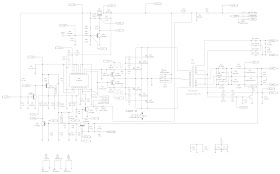 JBL GTO301.1 - GTO601.1 - GTO1201.1 - INSTALLATION - WIRING - SCHEMATICS - TROUBLESHOOTING TABLE
JBL GTO301.1 - GTO601.1 - GTO1201.1 - INSTALLATION - WIRING - SCHEMATICS - TROUBLESHOOTING TABLE
INSTALLATION & SETUP
Setting the Crossover [s]
- Determine your system plans and set the crossover mode switch accordingly. If you plan to use the GTO75.2 or GTO75.4 to drive full-range speakers, set the crossover mode to FLAT and skip to “Setting Input Sensitivity.”
- Initially set the crossover frequency control midway. While listening to music, adjust the crossover for the least perceived distortion from the speakers, allowing them to reproduce as much bass as possible.
- Systems using a separate subwoofer set the crossover mode to HP (high pass) for your full-range speakers. Adjust the crossover frequency to limit bass and provide increased system volume with less distortion.
- For subwoofers, choose the highest frequency that removes vocal information from the sound of the subwoofer.
- If using the GTO75.2 or GTO75.4 to drive a subwoofer(s), set the crossover mode to LP (low pass).
SETTING INPUT SENSITIVITY
- Initially turn the INPUT LEVEL control(s) to minimum (counter clockwise).
- Reconnect the (–) negative lead to the vehicle’s battery. Apply power to the audio system and play a dynamic music track.
- On the source unit, increase the volume control to 3/4 volume. Slowly increase the INPUT LEVEL control(s) toward three o’clock until you hear slight distortion in the music. Then reduce the INPUT LEVEL slightly until distortion is no longer heard.
REMOTE LEVEL CONTROL
- The GTO755.6 and all three GTO subwoofer amplifiers have inputs for an optional remote level control (RLC). This will allow the amplifier’s input level to be adjusted from the listening position. Connect the optional remote level control using the RJ-11 jack on the side of the amplifier. Install the control module in the front of the vehicle within easy reach of the driver. Under the dash or in the center console are both suitable locations.
THE BASS BOOST SETTING
- The GTO755.6, GTO301.1, GTO601.1 and GTO1201.1 are all equipped with a bass-boost control. This allows you to adjust the bass output of your system at 50Hz up to 12dB and enhance low frequency.
AUX OUTPUT
- GTO amplifiers (except GTO755.6) are equipped with full-range outputs that can be used to connect additional amplifiers. NOTE: When using the high-level inputs, the AUX outputs can be used to pass a line-level signal to another amplifier.
Control end panel {Click on images to Magnify}
INSTALLING NEON TUBES
- Using a Phillips screwdriver, remove all screws on the amplifier’s output/power end panel and set them aside.
- Using a 3 ⁄ 32-inch Allen wrench, remove only the screws on the amplifier’s (top) clear cover and set them aside.
- Remove the end panel and slide the cover off. Set both parts aside.
- Locate the enclosed hardware bag and remove the four clips. Each clip has a square end and a larger round end. Using a round end, press two clips onto each neon tube (e.g., Street Glow AN9 or equivalent).
- For each tube, align both clips so the square ends slide onto an exposed extrusion edge. Do not cover any screw holes. When installed correctly, each neon tube will sit under an extrusion and not be visible when viewed from directly above.
- Route each neon tube’s power cable through its respective NEON hole on the end panel.
- Slide the cover back into place and re-install its screws. Then, replace the end panel and reinstall its screws.
- Finish the installation of the neon tubes as instructed in their owner’s manual.
Neon Tube Installation
WIRING DIAGRAM
SCHEMATICS
[power amp-1]
[Power amp-2]
TROUBLESHOOTING






